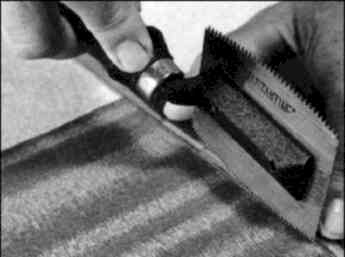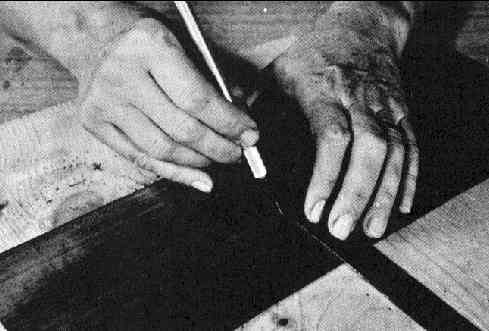Trimming Veneer to Size
The two most commonly used tools to cut and trim veneer are a veneer saw and a craft knife. I will cover the use of both these tools in this document.
Veneer Saw

The veneer saw is a neat little tool to cut veneer. Its teeth have no set and therefore it cuts straight and resists the pull of stubborn grain which is very important especially when you are ripping (cutting with the grain) veneer. When used properly, the saw will also produce a relatively clean cut. Because it has no set, it will leave a very narrow kerf.
Crosscutting With The Veneer Saw
To cut veneer to length you must cut against the grain of the wood. The grain usually runs parallel with the length of the veneer, therefore you must make a cut that is roughly 90 degrees to the grain direction. Place a backing board on your workbench so you when you cut through the veneer, you will not damage your workbench surface. Now lay your veneer on top of the backing board. If your cut has to be exactly square, use a trysquare or other accurate square. Use a pencil to mark your cut line on the face of the veneer. IMPORTANT NOTE: Always cut veneer slightly oversize, then after it is glued down, trim it flush to edges of workpiece. lay a metal or aluminum straightedge along the pencil line and place the back of the veneer saw against the straightedge. make sure the saw will be cutting on the waste side of the veneer, this way if you make a mistake, it will not ruin your good stock. Refer to photo above for proper position of saw against straightedge. When cutting against the grain, always cut from both edges toward the center of the piece. If you attempt to cut across the grain from one edge to the other, the veneer will most likely split of on the trailing edge. Do not try to cut through the veneer in one pass, take light passes until the saw cuts completely through the veneer. Some thicker and harder veneers may take longer to cut.
Ripping With The Veneer Saw
Basicially, ripping (cutting with or parallel with the grain) is preformed the same way as crosscutting with the exception of a few things. Fist, unlike crosscutting, you don't have to cut from one end into the center to avoid splitting. The trailing edge will not split out when ripping. Second, extra care should be taken to keep the saw from pulling away from the straightedge. When ripping, the tool has a tendency to pull away from the straightedge because alternating hard and soft streaks in the grain pattern The tool can catch in a soft area and pull away from the straightedge or hit a hard area and skip over the straightedge. Other than these two points, the method is the same as crosscutting.
Craft Knife 
One of the best ways to acheive a clean, sharp cut is to use a craft knife. Commonly used by artists and hobbists, this tool has a metal handle with a slit jaw at the top which accepts razor sharp blades of many shapes. The shape best suited for cutting veneers is a #11 type blade. This blade has a very sharp point that will score as well as cut through veneer leaving a clean edge with no chipping.
Using The Craft Knife
The craft knife is used in a similar manner to the veneer saw. make sure you take very light scoring passes with the tip of the knife. Once again, when crosscutting, cut into the center from both edges. The craft knife has more of a tendency to pull away from the straightedge than the veneer saw so be careful.
|
|
Return to Table of Contents CLICK HERE

Return To Sal Marino's Homepage
